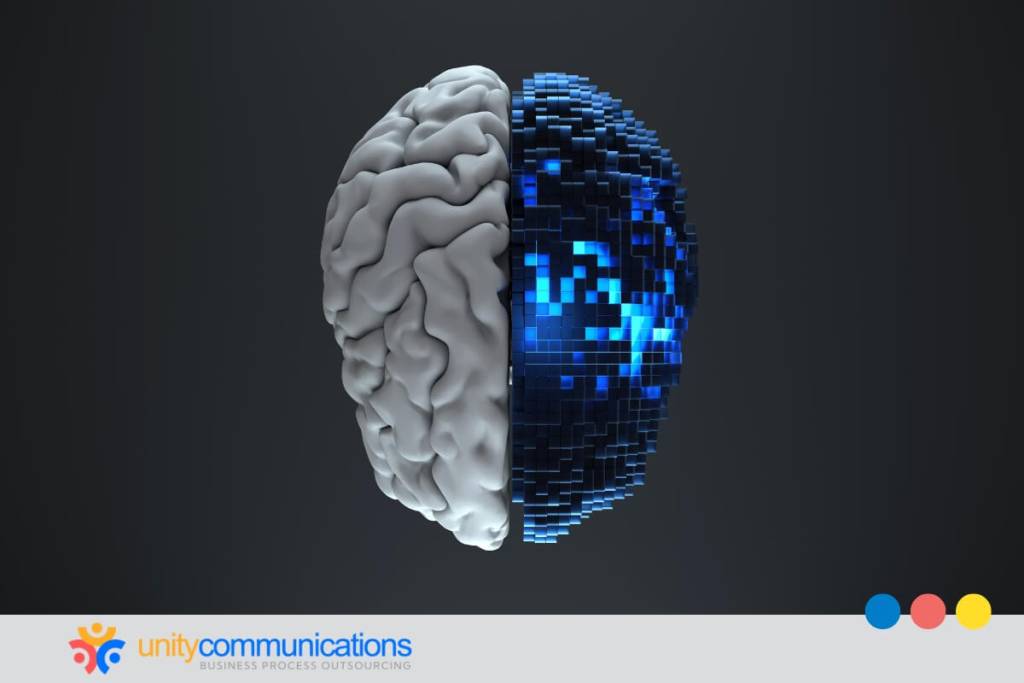Table of Contents
Companies increasingly use artificial intelligence (AI) to enhance their outsourcing strategies and improve efficiency, cost-effectiveness, and competitiveness. According to IBM research, 42% of large enterprises already use AI in their operations, and this figure continues to grow as organizations seek to stay competitive.
As AI adoption grows, it is reshaping how enterprises approach business process outsourcing, driving significant changes in the industry.
This article explores the remarkable outsourcing transformation via AI, covering its benefits, key applications, implementation steps, challenges, and practical strategies for maximizing the technology. Let’s dive in.
Why AI is changing the outsourcing game

The BPO industry is experiencing a significant shift, with AI driving efficiency, automation, and innovation across business processes. But what is BPO, and what is its connection to AI?
BPO refers to delegating specific business functions to external providers. Traditionally, outsourcing relied on manual processes and large workforces to handle repetitive tasks such as customer service, data entry, and back-office operations. Although this approach offered cost savings, it was inefficient, riddled with human errors, and difficult to scale.
AI-enabled outsourcing revolutionizes the industry by:
- Automating routine tasks and processes
- Enhancing decision-making
- Improving service delivery quality
AI algorithms now influence every stage of the outsourcing life cycle, from vendor selection and contract negotiation to process automation and performance monitoring.
Technologies and software, including natural language processing (NLP), predictive analytics, robotic process automation (RPA), and machine learning (ML), streamline workflows, optimize resources, and provide data-driven insights. This shift allows organizations to save costs, boost efficiency, and provide a more satisfying customer experience.
Outsourcing transformation via AI is no longer a distant possibility, as it reshapes how businesses operate, drive innovation, and compete in the global market.
Top 5 benefits of using AI in your outsourcing strategy
Integrating AI into BPO operations has many advantages. Here’s how incorporating AI into your BPO strategy pays off:
1. Major cost savings
Automating routine tasks and optimizing workflows can reduce human error and labor costs, leading to substantial savings. A Boston Consulting Group (BCG) study shows that 54% of leaders expected AI to drive cost savings in 2024, with nearly half anticipating savings exceeding 10%.
2. Enhanced efficiency
AI improves efficiency by processing massive datasets in real time, streamlining operations, and accelerating decision-making.
An EY India report projects that the technology could increase productivity in call center management by 80% and software development by 61%, resulting in faster turnaround times and greater operational agility across industries.
3. Improved customer experience
Besides efficiency and cost, outsourcing transformation via AI significantly improves the customer experience through personalized, seamless interactions.
AI-powered virtual assistants and chatbots provide 24/7 support, improving response times and satisfaction. Microsoft’s autonomous AI agents, designed to handle client inquiries, showcase the tech’s potential to enhance customer service.
4. Strategic data insights
Additionally, AI delivers invaluable data-driven insights. Predictive analytics empowers your business to identify emerging trends, anticipate problems, and make strategic decisions.
5. More focus on core competencies
Finally, AI allows your team to refocus on their core competencies. According to EY, 24% of tasks across industries can be fully automated, while AI can enhance another 42%, saving knowledge workers eight to ten hours per week.
By eliminating mundane work, AI frees up human resources for higher-value, strategic initiatives that drive innovation and growth.
How AI is reshaping BPO workflows

The global BPO market could grow to $414.81 billion in 2025 at a compound annual growth rate (CAGR) of 4.33%, reaching $491.53 billion by 2029. Integrating AI into the development of outsourcing workflows reshapes various business processes, enhancing efficiency, accuracy, and decision-making.
Several key AI applications transform outsourcing workflows, including:
- Robotic process automation (RPA) uses AI to automate repetitive and rule-based tasks such as data entry and processing. It minimizes errors and manual effort, allowing human agents to handle more complex activities.
- Natural language processing (NLP) powers chatbots and virtual assistants for customer service by teaching computers to understand and process human language. These AI-driven tools provide 24/7 assistance, improving response times and customer satisfaction.
- Predictive analytics examines historical data and AI algorithms to determine possible outcomes, anticipate demand, optimize resource allocation, and mitigate risks.
- Machine learning (ML) empowers systems to learn from data without explicit programming, continuously improving critical areas such as fraud detection and quality control.
AI solutions shake up outsourcing functions such as customer support, finance, HR, and IT services. Outsourcing transformation via AI drives efficiency, lowers costs, and enhances service quality, giving your business a competitive edge.
How to successfully integrate AI into your outsourcing model
To achieve the benefits of incorporating technology in outsourcing, you should follow a structured approach that aligns AI initiatives with your overarching goals. Consider these strategic steps:
1. Identify the right processes
Pinpointing specific outsourcing tasks that would benefit the most from AI. Focus on repetitive, data-intensive processes where automation can offer immediate improvements. For instance, automating data entry in finance or deploying chatbots in customer support can lead to quick wins, such as improved customer satisfaction.
2. Choose the right partners
Choose AI technologies and BPO providers that can fulfill your needs and align with your business goals. Assess possible partners according to their experience, performance history, and adaptability. A strategic partnership ensures that the AI tools are effective and scalable.
3. Integrate with existing systems
Seamlessly incorporate AI solutions into your current workflows. This might involve data migration, system integration, and process redesign to ensure compatibility and optimal performance. Proper integration minimizes disruptions and maximizes the benefits of AI deployment.
4. Train and upskill your team
Teach your team how to use AI tools to enhance productivity and cultivate an innovative and flexible organizational culture. Organize training programs to assist staff in adapting to automation and decrease resistance to uncertainty, job security concerns, and workflow changes.
5. Monitor and evaluate performance
Continuously assess the performance of AI solutions against predefined metrics. Regular monitoring allows for timely adjustments and ensures that the AI initiatives deliver the expected outcomes.
Overcoming common AI challenges in BPO implementation

Although outsourcing transformation via AI offers numerous advantages, you can still encounter challenges during adoption. Resolving these issues is essential for successful implementation.
- Data quality and availability. AI algorithms require large volumes of high-quality data to produce valuable insights.
Solution: Establish clear rules for managing and protecting data. Regular audits and cleansing can also maintain data integrity.
- Integration with existing systems. Adding AI solutions into current workflows and legacy systems can be complex and time-consuming.
Solution: Thoroughly assess existing infrastructures to identify integration points. Collaborate with experienced AI vendors to minimize disruptions during integration.
- Skill gaps and expertise. A shortage of AI specialists can impede its implementation and management.
Solution: Invest in training programs to upskill current employees, particularly BPO agents. Additionally, consider hiring specialists or partnering with firms with AI expertise.
- Employee resistance to change. Workers might oppose AI programs, fearing that automation might replace their jobs.
Solution: Communicate AI’s benefits to employee productivity and efficiency to foster a culture of transparency. Emphasize that AI aims to augment, not replace, human roles.
- Ethical and data privacy concerns. Using AI raises data privacy and ethical issues, especially when handling sensitive information.
Solution: Establish clear ethical guidelines and comply with data protection regulations. Review AI systems regularly to prevent biases and uphold ethical standards. This entails preventing prejudice in AI algorithms and ensuring that AI judgments are equitable, open, and in accordance with data protection laws, such as the GDPR.
By proactively addressing these challenges, you can harness AI’s potential in outsourcing, leading to enhanced efficiency, cost savings, and improved service quality.
The bottom line
AI is transforming the outsourcing industry, helping your business achieve greater efficiency, cost-effectiveness, and operational excellence. By integrating the technology into outsourcing strategies, you can optimize workflows, enhance decision-making, and improve the customer experience.
Despite its challenges, outsourcing transformation via AI offers substantial benefits. For example, it can give you a competitive edge that can translate to revenue, cost savings, increased efficiency, and improved service quality.
If you want to learn more about the connection between outsourcing strategies and AI, let’s connect.




